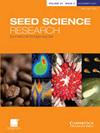Developing soybean seed germination: low ABA and high EXP1 gene expression promote embryonic axis growth whereas the seed coat delays radicle protrusion
IF 1.9
3区 生物学
Q2 PLANT SCIENCES
引用次数: 0
Abstract
Abstract Seed germination implies an expansion process restarting the growth of the embryonic axis (Ax) and which is completed by radicle emergence through the seed covering layers. In developing soybean seeds, abscisic acid in Ax (ABAa) mainly inhibits Ax growth. Additionally, the expression of the EXP1 gene at the elongation zone (EZ) was found to be involved in the promotion of mature soybean Ax growth, which increased during water incubation and which was repressed by exogenous ABA. This work aimed to evaluate (1) the ABAa and EXP1 levels at the EZ and (2) the role of the seed coat (SC) in developing soybean seed germination. Whole seeds (Se), embryos (Em) and Ax at 25–45 d after anthesis (DAA) germinated in vitro, and germination performance increased with DAA. ABAa decreased in planta from 25 DAA until its critical non-inhibitory threshold (ABAc) at around physiological maturity (45 DAA). At earlier ages, the ABAc was reached during the in vitro incubation. Concomitantly, EXP1 transcripts accumulated with age into the pool of long-lived mRNAs and were up-regulated during incubation. Additionally, isolated Ax germinated faster, took up more water and increased its water potential more rapidly during incubation than Ax in Se. Also, a lower osmotic gradient was required to germinate at 45 DAA, when ABAa was no longer inhibitory. Simultaneously, the pressure to protrude SC through the micropylar area increased from 25 to 45 DAA. These results support the role of ABAa and EXP1 in controlling Ax growth and the SC in delaying radicle protrusion.发育中的大豆种子萌发:低ABA和高EXP1基因表达促进胚轴生长,种皮延缓胚根突出
摘要种子发芽意味着一个重新开始胚胎轴(Ax)生长的膨胀过程,通过种子覆盖层的胚根发芽来完成。在大豆种子发育过程中,Ax中的脱落酸(ABAa)主要抑制Ax的生长。此外,发现EXP1基因在延伸区(EZ)的表达参与促进成熟大豆Ax的生长,Ax在水培养过程中增加,并被外源ABA抑制。本工作旨在评估(1)EZ的ABAa和EXP1水平,以及(2)种皮(SC)在大豆种子发芽过程中的作用。花后25–45天的全种子(Se)、胚胎(Em)和Ax(DAA)在体外发芽,发芽性能随DAA的增加而提高。植物体内ABAa从25 DAA开始下降,直到生理成熟(45 DAA)时达到其临界非抑制阈值(ABAc)。在早期,ABAc是在体外培养过程中达到的。同时,EXP1转录物随着年龄的增长而积累到长寿命mRNA库中,并在孵育过程中上调。此外,与Se中的Ax相比,分离的Ax在培养过程中发芽更快,吸收更多的水,并更快地增加其水势。此外,当ABAa不再具有抑制性时,在45DAA下发芽需要更低的渗透梯度。同时,SC通过珠孔区域突出的压力从25 DAA增加到45 DAA。这些结果支持ABAa和EXP1在控制Ax生长和SC延缓胚根突出中的作用。
本文章由计算机程序翻译,如有差异,请以英文原文为准。
求助全文
约1分钟内获得全文
求助全文
来源期刊

Seed Science Research
生物-植物科学
CiteScore
3.60
自引率
4.80%
发文量
23
审稿时长
>12 weeks
期刊介绍:
Seed Science Research, the official journal of the International Society for Seed Science, is a leading international journal featuring high-quality original papers and review articles on the fundamental aspects of seed science, reviewed by internationally distinguished editors. The emphasis is on the physiology, biochemistry, molecular biology and ecology of seeds.
 求助内容:
求助内容: 应助结果提醒方式:
应助结果提醒方式:


